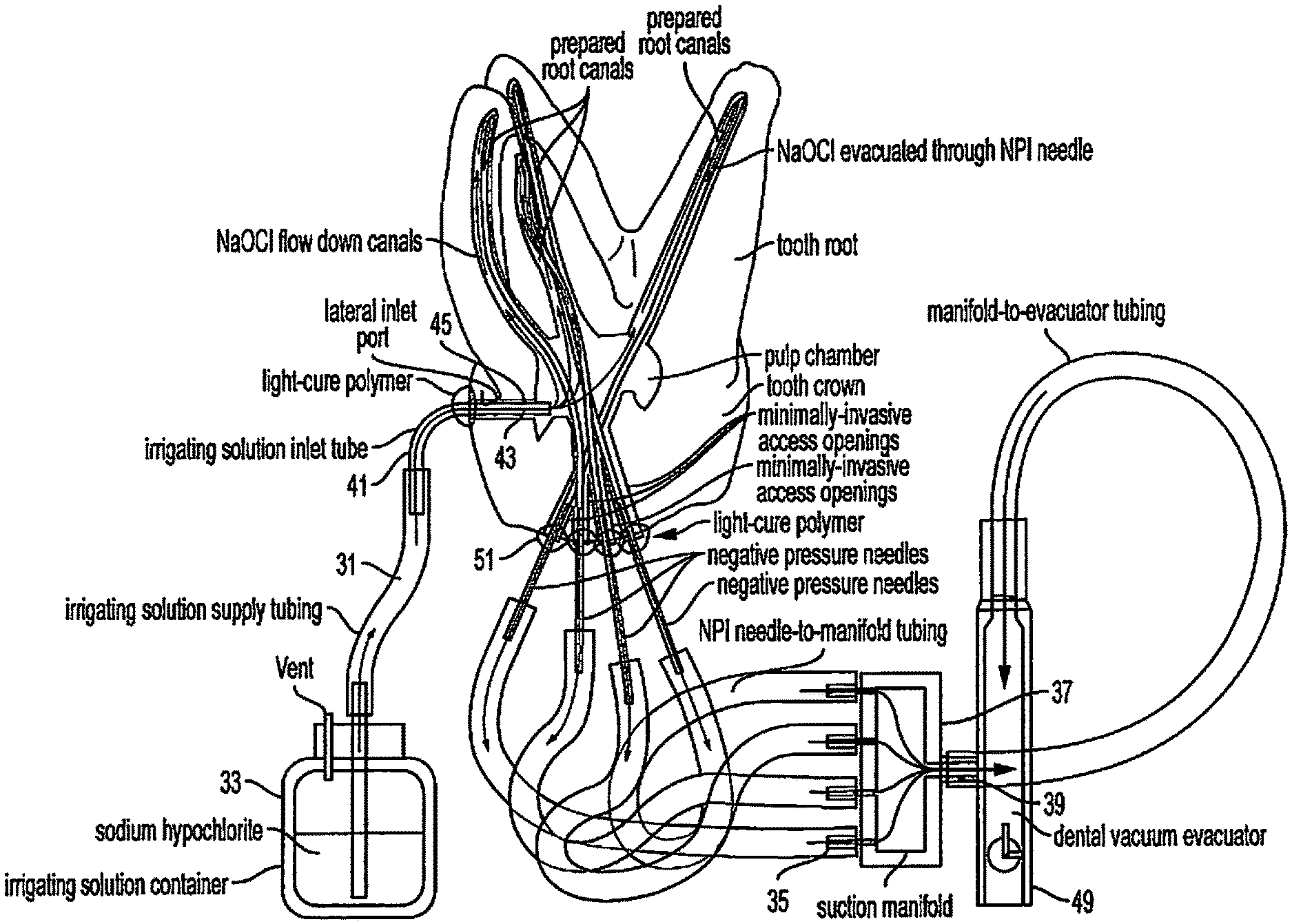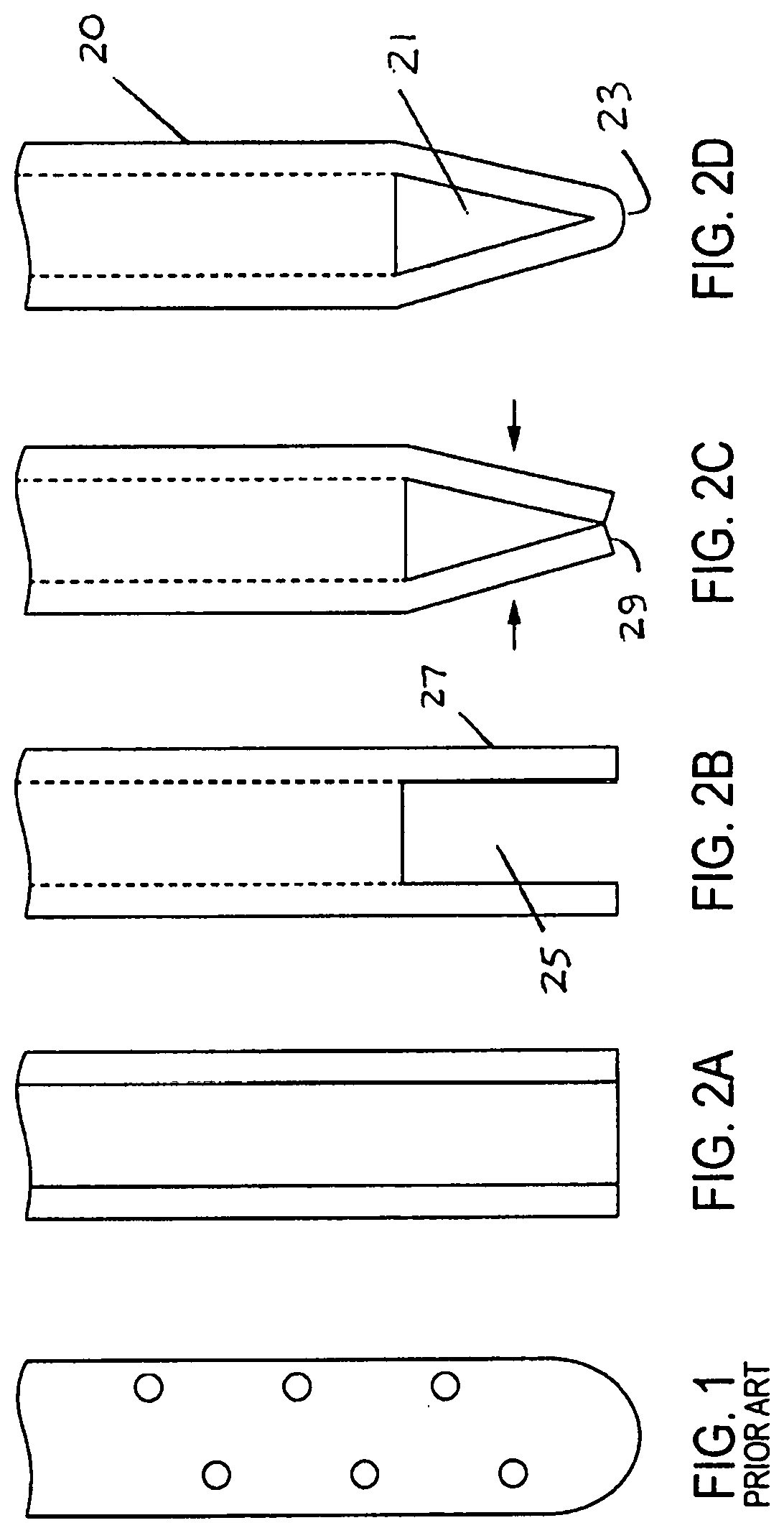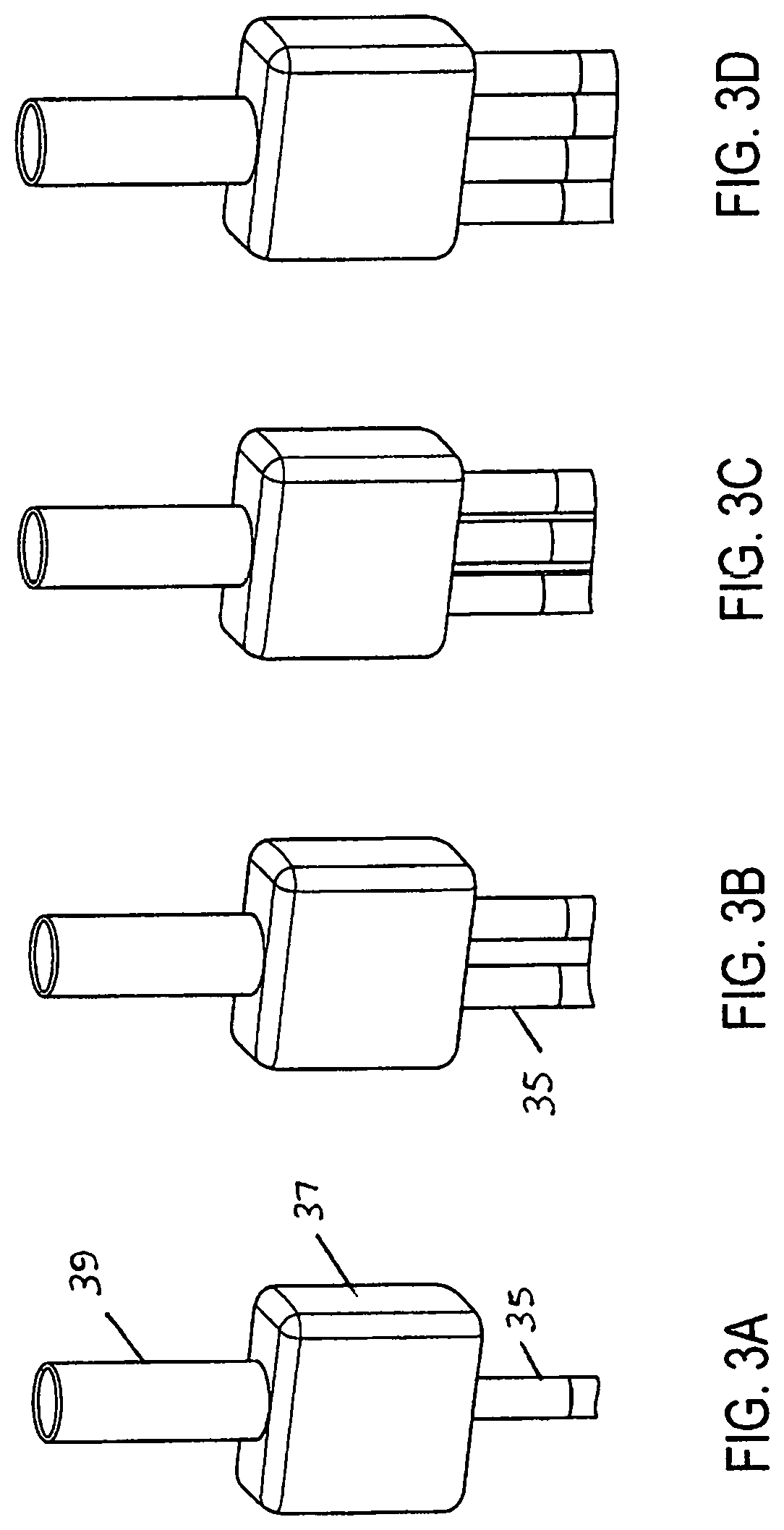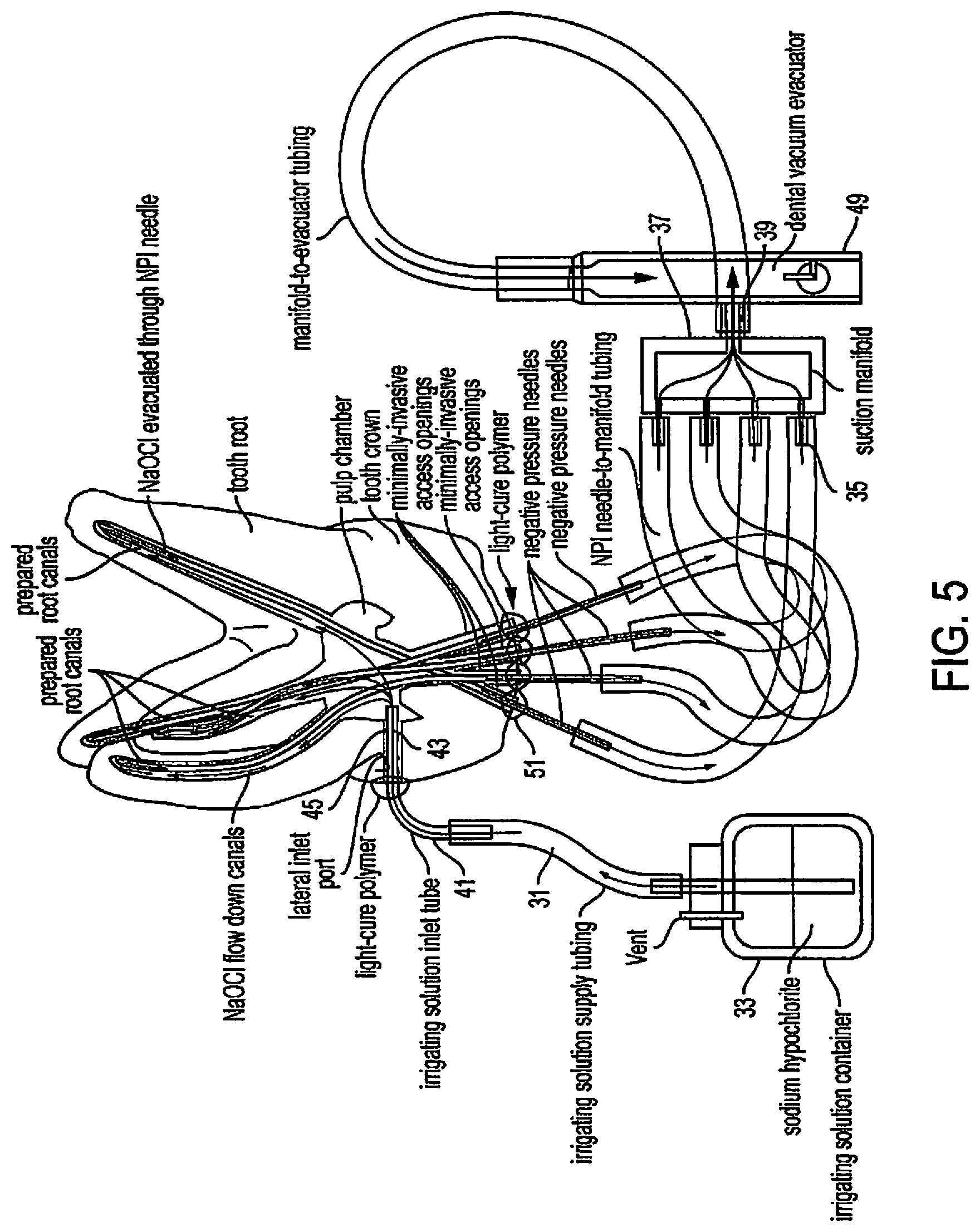Multi-cannula negative pressure irrigation system
Buchanan Sept
U.S. patent number 10,779,920 [Application Number 15/750,248] was granted by the patent office on 2020-09-22 for multi-cannula negative pressure irrigation system. The grantee listed for this patent is L. Stephen Buchanan. Invention is credited to L. Stephen Buchanan.





| United States Patent | 10,779,920 |
| Buchanan | September 22, 2020 |
Multi-cannula negative pressure irrigation system
Abstract
This invention relates to a negative pressure irrigation system including one or more negative pressure irrigation needles sized for insertion into a canal of a tooth, each needle having a closed distal end and two suction inlet ports located opposite one another immediately proximal to the closed distal end. The needles are placed in communication with a dental vacuum system by way of a suction manifold. An irrigant inlet tube supplies irrigant from a irrigant container into a pulp chamber or a tooth. The irrigant inlet tube may include a tapered end designed to tightly fit into a lateral irrigant supply port previously drilled into the pulp chamber. A light-cure polymer seals the inlet tube and needles when in use.
| Inventors: | Buchanan; L. Stephen (Santa Barbara, CA) | ||||||||||
|---|---|---|---|---|---|---|---|---|---|---|---|
| Applicant: |
|
||||||||||
| Family ID: | 1000005067054 | ||||||||||
| Appl. No.: | 15/750,248 | ||||||||||
| Filed: | December 5, 2016 | ||||||||||
| PCT Filed: | December 05, 2016 | ||||||||||
| PCT No.: | PCT/US2016/064978 | ||||||||||
| 371(c)(1),(2),(4) Date: | February 05, 2018 | ||||||||||
| PCT Pub. No.: | WO2017/096382 | ||||||||||
| PCT Pub. Date: | June 08, 2017 |
Prior Publication Data
| Document Identifier | Publication Date | |
|---|---|---|
| US 20180338821 A1 | Nov 29, 2018 | |
Related U.S. Patent Documents
| Application Number | Filing Date | Patent Number | Issue Date | ||
|---|---|---|---|---|---|
| 62262897 | Dec 3, 2015 | ||||
| Current U.S. Class: | 1/1 |
| Current CPC Class: | A61C 5/40 (20170201); A61C 17/0208 (20130101); A61C 17/02 (20130101) |
| Current International Class: | A61C 17/02 (20060101); A61C 5/40 (20170101) |
| Field of Search: | ;433/91,214,215,224 |
References Cited [Referenced By]
U.S. Patent Documents
| 2173637 | September 1939 | Riedener |
| 2862495 | December 1958 | Gewecke |
| 3181336 | May 1965 | Schofield |
| 3871099 | March 1975 | Kahn |
| 4021921 | May 1977 | Detaille |
| 4276880 | July 1981 | Malmin |
| 4993941 | February 1991 | Maita |
| 4993947 | February 1991 | Grosrey |
| 5171146 | December 1992 | Guerci |
| 6079979 | June 2000 | Riitano |
| 6386871 | May 2002 | Rossell |
| 6537068 | March 2003 | Kusano |
| 6997714 | February 2006 | Schoeffel |
| 7226288 | June 2007 | Schoeffel |
| 7270544 | September 2007 | Schemmer |
| 7891977 | February 2011 | Riva |
| 8827705 | September 2014 | Schoeffel |
| 9579485 | February 2017 | Oborn |
| 9713573 | July 2017 | Carlyon |
| 9839738 | December 2017 | Beauvais |
| 9872748 | January 2018 | Schoeffel |
| 2004/0193104 | September 2004 | Jervis |
| 2005/0170312 | August 2005 | Pond |
| 2005/0287498 | December 2005 | Schoeffel |
| 2006/0223026 | October 2006 | Kuroiwa |
| 2007/0244425 | October 2007 | Pond |
| 2007/0287125 | December 2007 | Weill |
| 2008/0014545 | January 2008 | Schippers |
| 2008/0032259 | February 2008 | Schoeffel |
| 2008/0138761 | June 2008 | Pond |
| 2008/0280252 | November 2008 | Riva |
| 2009/0004621 | January 2009 | Quan |
| 2010/0190133 | July 2010 | Martinez |
| 2014/0302454 | October 2014 | Maxwell |
| 2016/0067023 | March 2016 | Castelo Baz |
| 2017/0340413 | November 2017 | Burns |
| 2018/0153644 | June 2018 | Bosisio |
| 205339187 | Jun 2016 | CN | |||
Assistant Examiner: Saunders; Matthew P
Attorney, Agent or Firm: Gotwals; Gable
Parent Case Text
CROSS-REFERENCE TO RELATED APPLICATIONS
This application is the United States National Phase of Patent Application No. PCT/US2016/064978 filed 5 Dec. 2016, which claims priority to U.S. Provisional Application No. 62/262,897 filed 3 Dec. 2015, each of which are incorporated herein by reference.
Claims
What is claimed is:
1. An endodontic irrigation system comprising: a dental vacuum evacuator; two or more negative pressure irrigation needles each including a closed distal end and two suction inlet ports located opposite one another immediately proximal to the closed distal end; a suction manifold including a tube on one side connected to the dental vacuum evacuator and two or more tubes on another side of the suction manifold each arranged for connection to a corresponding one of the two or more negative pressure irrigation needles; an irrigant container; an irrigant inlet tube connected to the irrigant container; and a light-cure polymer first portion and second portion each portion spaced apart from the suction manifold, the light-cure polymer portions in an unpolymerized state, the first portion directly contacting and sealably surrounding a portion of the two or more negative pressure irrigation needles and the second portion directly contacting and sealably surrounding a portion of the irrigant inlet tube, the portions being directly adjacent to a formed hole each configured to respectively receive the two or more negative pressure irrigation needles and or the irrigant inlet tube between respective proximal and distal ends of the two or more negative pressure irrigation needles and of the irrigant inlet tube; the irrigant inlet tube forming a first irrigant passageway, one of the two or more negative pressure irrigation needles and its corresponding one of the two or more tubes forming a second different irrigant passageway independent of the first irrigant passageway, and another of the two or more negative pressure irrigation needles and its corresponding another one of the two of more tubes forming a third different irrigant passageway independent of the first and second different irrigant passageways; wherein when in an intended use the endodontic irrigation system draws irrigant from the irrigant container through the irrigant inlet tube and the irrigant is simultaneously suctioned down two or more canals each containing a corresponding one of the two or more negative pressure irrigation needles; and wherein the irrigant is simultaneously evacuated from the two or more canals through the two or more negative pressure irrigation needles, thus maintaining a closed system vacuum.
2. An endodontic irrigation system according to claim 1 further comprising the irrigant inlet tube including a tapered end (43).
3. An endodontic negative pressure irrigation according to claim 1 further comprising each suction inlet port being triangular in shape.
4. A negative pressure irrigation system according to claim 1 further comprising the two suction inlet ports being formed by: cutting a slot (25) into a square-cut tip end of a needle material; bending a remaining sidewall portion (27) of the needle material located on opposing sides of the slot toward one another so a respective tip end (29) of each remaining sidewall portion contacts an opposing respective tip end; and joining together the two tip ends when in contact with one another to create the closed distal end.
5. An endodontic irrigation system comprising: two or more negative pressure irrigation needles each including a closed distal end and two suction inlet ports located opposite one another immediately proximal to the closed distal end; a suction manifold including a tube on one side configured for connection to a dental vacuum evacuator and two or more tubes on another side of the suction manifold each arranged for connection to a corresponding one of the two or more negative pressure irrigation needles; an irrigant inlet tube configured for connection to an irrigant container; and a light-cure polymer first portion and second portion, each portion spaced apart from the suction manifold, the light-cure polymer portions in an unpolymerized state, the first portion directly contacting and sealably surrounding a portion of the two or more negative pressure irrigation needles and the second portion directly contacting and sealably surrounding a portion of the irrigant inlet tube, the portions each configured to respectively receive the two or more negative pressure irrigation needles or the irrigant inlet tube between respective proximal and distal ends of the two or more negative pressure irrigation needles and of the irrigant inlet tube; the irrigant inlet tube forming a first irrigant passageway, one of the two or more negative pressure irrigation needles and its corresponding one of the two or more tubes forming a second different irrigant passageway independent of the first if passageway, and another of the two or more negative pressure irrigation needles and its corresponding another one of the two of more tubes forming a third different irrigant passageway independent of the first and second different irrigant passageways; wherein when in an intended use the endodontic irrigation system draws irrigant from the irrigant container through the irrigant inlet tube and the irrigant k simultaneously suctioned down two or more canals each containing a corresponding one of the two or more negative pressure irrigation needles; and wherein the irrigant is simultaneously evacuated from the two or more canals through the two or more negative pressure irrigation needles, thus maintaining a closed system vacuum.
6. An endodontic irrigation system according to claim 5 further comprising a dental vacuum evacuator (49) and an irrigant container (33).
7. An endodontic irrigation system according to claim 5 further comprising the irrigant inlet tube including a tapered end (43).
8. An endodontic negative pressure irrigation according to claim 5 further comprising each suction inlet port being triangular in shape.
9. A negative pressure irrigation system according to claim 5 further comprising the two suction inlet ports being formed by: cutting a slot (25) into a square-cut tip end of a needle material; bending a remaining sidewall portion (27) of the needle material located on opposing sides of the slot toward one another so a respective tip end (29) of each remaining sidewall portion contacts an opposing respective tip end; and joining together the two tip ends when in contact with one another to create the closed distal end.
Description
BACKGROUND OF THE INVENTION
This invention is in the field of endodontic instruments and, more specifically, negative pressure irrigation systems for use in cleaning root canals.
Scientific research and clinical experience shows negative pressure irrigation ("NPI") to be 1) one of the most effective methods of cleaning or debriding root canals, 2) very inexpensive as it uses sodium hypochlorite, the most inexpensive and most universally accepted endodontic irrigating solution and the suction system found in every dental office, and 3) the safest method of applying the highly toxic sodium hypochlorite (NaOCl, common known as bleach) solution into root canals. Despite the exceptional efficacy shown by research and clinical experience, prior art NPI systems such as the EndoVac.TM. system (Kerr Endodontics) include several design features that have severely limited their use in clinical practice.
The first limiting feature is the needle, which includes 12 micro-ports within the first 1 mm near the distal end (see e.g. FIG. 1). The ports frequently clog as dental pulp fragments and cut dentin debris is sucked into the ports during use. The EndoVac needle, for example, has a size 0.32 mm external diameter, is a non-tapered needle with four sets of three laser-cut, laterally positioned offset holes are immediately proximal to its closed distal end (about the first 0.70 mm). Each hole of the set is 100.mu. in diameter (0.1 mm, smaller than the internal diameter of the needle) and spaced 100.mu. apart.
The second limiting feature is the time required by the clinician when using the system in multi-canaled teeth because the clinician must actively hold the NPI needle at the end of in a given canal as the solution is evacuated down the root canals and out into the suction system attached to the NPI needle. One positive aspect of PPI is that it has a multi-cannular effect, meaning that in teeth with multiple canals, they are all cleaned simultaneously with PPI irrigation.
Current NPI systems are limited to a uni-cannular effect, meaning that only a single canal at a time can be actively cleaned with NPI. Because of this, prior art NPI systems actually increase the dentist's workload in multi-cannular teeth. Currently, using NPI instead of PPI can reduce the time needed to complete cleaning of a root canal with NaOCl from 40 minutes (PPI) to 5 minutes (NPI), however if NPI requires five minutes of constant NPI irrigation per canal, that necessity times four equals twenty continuous minutes of attention required by the dentist rather than only ten minutes of the dentist's time spent actively irrigating with PPI.
The third limiting feature is that NPI currently requires constant attention by the clinician to repeatedly add NaOCl to the access cavity as the solution is drawn to the end of the canal and is evacuated through the NPI needles. Whether the tooth being treated needs five minutes or 20 minutes of constant attention during NPI irrigation, it is much effort expended for a very simple need, replenishment of solution.
SUMMARY
The preferred embodiments of a multi-cannular negative pressure irrigation ("NPI") system as disclosed here resolves all of the prior art limitations outlined above and offers the safest, least expensive, and most effective method currently known to endodontic treatment.
In a preferred embodiment, the NPI system includes one or more negative pressure irrigation needles each having a closed distal end and two suction inlet ports located opposite one another immediately proximal to the closed distal end. The ports may be triangular in shape and, because of their size, are the only ports required along the needle. Preferably, no other suction ports are proximal to these.
The needles are placed in communication with a dental vacuum system by way of a suction manifold. On one side of the suction manifold, there is a single tube arranged for connection to the dental vacuum system. On another side of the manifold, there are one or more needle tubes, each arranged for connection to a corresponding negative pressure irrigation needle.
An irrigant inlet tube supplies irrigant from a irrigant container into a pulp chamber or a tooth. The irrigant inlet tube may include a tapered end designed to tightly fit into a lateral irrigant supply port previously drilled into the pulp chamber.
When in use the irrigant inlet tube is placed into the pulp chamber of the tooth and, along with the negative pressure irrigation needles which are placed in a respective canal of the tooth, is sealed with a light-cure polymer at a cavo surface of an access cavity. This creates a negative pressure environment that draws irrigant from the irrigant container through the irrigant inlet tube and into the pulp chamber, after which the irrigant is suctioned down a canal and is evacuated from the canal by the negative pressure irrigation needle, thus maintaining a closed system vacuum.
The NPI needle's suction ports may be formed by cutting a slot into a square-cut tip end of a needle material; bending a remaining sidewall portion of the needle material located on opposing sides of the slot toward one another so a respective tip end of each remaining sidewall portion contacts an opposing respective tip end; joining, welding, or bonding together the two tip ends when in contact with one another to create the closed distal end.
BRIEF DESCRIPTION OF THE DRAWINGS
FIG. 1 is a prior art negative pressure irrigation ("NPI") needle.
FIG. 2A is a preferred embodiment of a NPI needle prior to a first step of its fabrication process.
FIG. 2B is the needle of FIG. 2A after a slot is cut into the tip end.
FIG. 2C is the needle of FIG. 2B after opposing ends of the slot are brought together.
FIG. 2D is the needed of FIG. 2C after the ends are welded together, providing two inlet ports, one on each side of the needle, for suction.
FIG. 3A is a preferred embodiment of a NaOCl inlet tube and a single suction tube connected to a manifold.
FIG. 3B is a preferred embodiment of the manifold with two suction tubes, each corresponding to a respective NIP needle.
FIG. 3C is a preferred embodiment of the manifold with three suction tubes.
FIG. 3D is a preferred embodiment of the manifold with four suction tubes.
FIG. 4 is an example of a preferred embodiment of the system used in connection with a conventional access cavity cut into the pulp chamber.
FIG. 5 is another example of the system applied through the crown of a molar tooth that has been entered with a multiplicity of minimally invasive access holes, plus a lateral inlet port hole to feed the NaOCl solution into the pulp chamber.
ELEMENTS AND NUMBERING USED IN THE DRAWINGS AND DETAILED DESCRIPTION
10 Negative pressure irrigation system 20 Needle or cannula 21 Suction inlet port 23 Tip or distal end 25 Slot 27 Remaining sidewall adjacent slot 29 End of 27 30 Tubing system 31 Irrigant supply tubing 33 Irrigant container 35 Needle tubing 37 Suction manifold 39 Evacuator tubing 41 Irrigant inlet tube or cannula 43 Tapered end 45 Lateral irrigant supply port 49 Dental vacuum system 51 Light-cure polymer
DETAILED DESCRIPTION OF THE PREFERRED EMBODIMENTS
Referring to FIGS. 2A-D, a preferred embodiment of a negative pressure irrigation ("NPI") system 10 includes a NPI needle or cannula 20 with two suction inlet ports 21 at its tip end 23. The ports 21 are preferably non-circular in shape. Unlike the prior art, the ports 21 are the only ports within the first 1 mm from the tip end 23 and, preferably, are sized in a range of greater than 0.1 mm and less than an internal diameter of the needle 20.
The inlet ports 21 of the needle 20 are preferably made by cutting a slot 25 in the tip end 23 of a needle material such as stainless steel or its equivalent; bending the remaining opposing sidewall portions 27 until their respective ends 29 touch; and joining, welding, or bonding together the now-touching ends 29 together. This arrangement provides the needle 20 with a maximum size of inlet ports 21 so the port 21, as well as the needle 20, is less likely to clog with pulp remnants and cut dentin debris. The closed tip end 23 prevents periapical tissue fluids from being suctioned up the needles instead of the intended irrigant (e.g. NaOCl) that is coursing down each of the canals alongside the needle or needles 20 that evacuate the canals.
Referring to FIGS. 3A-D, NPI system 10 includes a tubing system 30 reduced to just a single irrigant supply tubing or line 31 connected to an irrigant container 33, a NPI needle tubing 35 connected to the needle 20 and to one side of a suction manifold 37, and a single evacuator tubing 39 connected on the other side of the suction manifold 37 and to a dental evacuation system 49. The irrigant supply line 31 may include an irrigant inlet tube 41 with a tapered end 43 designed to tightly fit into a lateral irrigant supply port 45 previously drilled into a pulp chamber (see e.g. FIG. 4). The manifold 37 may have two or more NPI needle tubes 35 each arranged for connection to a corresponding NPI needle 20 for each canal in a given tooth.
The preferred embodiment of system 10 allows NPI needles 20 to be placed through the access cavity and to the end of each canal of a given tooth, along with an irrigant supply port 45 placed just into the pulp chamber of the tooth, after which a light-cure polymer 51 is syringed around these needles 20 and the irrigant supply port 45 to seal the access cavity so that all canals can be cleaned simultaneously, rendering the time needed for NPI in a four canal molar tooth, for example, to drop from 40 minutes to 10 minutes in total, without additional time required by the treating clinician.
FIGS. 4 & 5 show two examples of system 10's application. The first example is in a tooth with a conventional access cavity cut into the pulp chamber. Each of the NPI needles 20 is inserted into the end points of the prepared canals, and an NaOCl inlet supply port 45 is placed, to feed solution into the pulp chamber. Each cannula is sealed with a light or chemically cured polymer 51 to create a closed system that automatically draws the NaOCl solution into the tooth through the vacuum delivered by the NPI needles 20 in each canal.
The second example shows system 10 applied through the crown of a molar tooth that has been entered with a multiplicity of minimally invasive access holes, cut by micro-burs or laser, plus a lateral inlet supply port 45 to feed the NaOCl solution into the pulp chamber alongside the NPI needles 20 in each canal. As in the first example, each of these cannulas is sealed with a light or chemically cured polymer 49 that is easily removed after irrigation has been completed.
* * * * *
D00000

D00001

D00002

D00003

D00004

XML
uspto.report is an independent third-party trademark research tool that is not affiliated, endorsed, or sponsored by the United States Patent and Trademark Office (USPTO) or any other governmental organization. The information provided by uspto.report is based on publicly available data at the time of writing and is intended for informational purposes only.
While we strive to provide accurate and up-to-date information, we do not guarantee the accuracy, completeness, reliability, or suitability of the information displayed on this site. The use of this site is at your own risk. Any reliance you place on such information is therefore strictly at your own risk.
All official trademark data, including owner information, should be verified by visiting the official USPTO website at www.uspto.gov. This site is not intended to replace professional legal advice and should not be used as a substitute for consulting with a legal professional who is knowledgeable about trademark law.